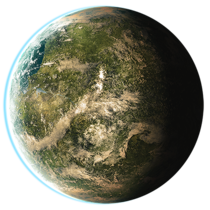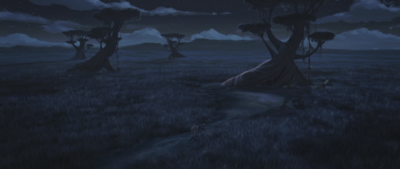Maridun (Planet)
| Maridun | |

| |
| Location | |
| System | Maridun |
| Sector | Rolion |
| Galactic Coordinates | (249, 253) |
| System Coordinates | (12, 6) |
| Astrographic Entry | Maridun |
| Statistics | |
| Type | temperate/breathable |
| Primary Terrain: | grassland |
| Rotational Period | 27 hours |
| Orbital Period | 420 days |
| Population | 599,051 inhabitants |
| Control | |
| Controlled By | None |
| Governor | |
| Magistrate | |
| Sentient Races | Amani |
Home of the Amani race, planet Maridun is a dusky prairie world situated between the Hydian Way and Perlemian Trade Routes in the Outer Rim Territories.
History
While Maridun's sun is unusually dim, the planet's Force aura is particularly bright. That is what attracted the Rakata, whose technology could detect and reach the planet because of its Force energy. Thus Maridun became one of the core realms of the Infinite Empire nearly 30,000 years ago. All traces of that despotic civilization have since disappeared, having been intentionally dismantled during the slave revolts.
With the collapse of the Infinite Empire, Maridun was mostly forgotten by the rest of the galaxy. The system went largely overlooked for the next 20,000 years until it was patrolled by Neo-Crusader scouts serving Mandalore the Ultimate. After the Battle of Malachor V, a few routed Mandalorians fled to Maridun seeking refuge from the Galactic Republic. But they did not develop a permanent colony. Just 300 years later, when Freia Kallea arrived seeking to connect the Morellian Trail and Spurs of Celanon, the planet was cataloged as being wild and uninhabited. It is thought that the abandonment of Maridun may have been due to the hostility of the native Amanin, the warlike race of headhunters who inhabit the forested regions.
As the Galactic Republic itself began to crumble, Lurmen, Hutts and other refugees and fugitives again began to arrive on Maridun seeking sanctuary from the conflict. This time, the settlers managed to achieve equilibrium with the Amani tribes and could live in relative peace by restricting their activity to the uncontested territories along the western shore of Maridun's largest ocean.
What began as a rough pioneer town has gradually transformed into an orderly, modern city with its own Star Tours terminal. Merchants, craftsmen, smugglers, and slavers all mingle profitably with the friendlier Amani tribes, who visit the city seeking to trade for technology.
Geology
Maridun is a terrestrial world that spins on a stable axis around its parent star. A bisected crust forms a fault line that runs along the center of the surface and turns roughly east in the northern hemisphere, pushing up three small mountainous regions. The two deepest depressions, located in opposite hemispheres, have filled with seawater. Without any moons or companion planets, the seas on Maridun are not tidal. The crust is thought to be rich in assorted ores, but prospecting teams are routinely attacked by Amani warbands and all expeditions to date have failed.
Climate
Maridun has a Type I breathable atmosphere that is composed of nitrogen, oxygen and hydrogen without any detectable contamination. The hydrosphere is quite modest, with some of the largest water sources being trapped underground and seeping out through springs. Most of these springs support the massive rainforests that have grown above them, although three have created small rivers and the largest of these, the Bina and Berk, feed the twin seas. These land-locked saltwater bodies drive much of the weather on Maridun, which is generally mild but because of the planet's gentle tilt, also seasonal. The magnetosphere is relatively weak for a planet of Maridun's size, but the solar wind is also much less intense. Because of the feeble solar glare and sparse cloud cover, Maridun's night skies are breathtaking and the brightest local stars are even visible during daylight hours.
Flora and Fauna
Plant life on Maridun has evolved to thrive in low light and while the rate of growth is comparatively reduced, the tranquil winds and clement seasons have permitted the vegetation to reach tremendous sizes. The reeds and grasses that dominate the prairies are often as much as 2 meters tall and the trees on Meridun reach truly enormous heights.
Many of the animals that call Maridun home are common breeds that can be found on any other number of planets elsewhere in the galaxy. Scholars suggest that these species were introduced to Maridun by the Rakata in the distant past. Great Thranta, Falumpaset, Bantha, Acklay, Nerf, Reek, Nexu, Kaadu, Aak Dog, Corellian Sand Panther, Common Thranta, Boma Beast, and Squall have all adapted to Maridun's ecosystem and roam the vast grasslands where they are hunted by the Amanin.
Rancor, Acklay, Katarn, Vornskr, Gundark, Crystal Snake, Eye-snatcher and the dreaded Physallis Berry nest in the jungles where the Amanin build their tree villages, high up in the canopy.
The rocky crags of the mountains are host to packs of Varactyl, Draigon, Kell Dragon, Howlrunner, and D`oemir Bear.
But other species are exclusive to Maridun and do not appear anywhere else in the galaxy, and these are believed to be true native creatures. The hare-like Fwit, a small carnivorous mammal, is domesticated by Amanin and settlers alike. Carrier Butterflies are also domesticated to serve as couriers, being capable of repeating audio messages and following complex instructions. The Corianoth is a massive reptilian herbivore, a gentle giant that ranges the savannahs. The Charnoq is the one predator that the Amanin fear, an eight-legged horned reptile that is immune to toxins and known to climb. The Mastiff Phalone is a four-legged bird-like predator that stalks the plains. Due to Maridun's characteristic isolation, these breeds are largely unknown to the rest of the galaxy.
Settlement
Itinerant Amani tribes value the ability to move in any direction on short notice. Oceans and rivers hinder their freedom of movement and so it was discovered by the refugees and fugitives who settled on Maridun that their presence would not be contested if they stayed in close proximity to the shores. The first camp to grow into a genuine colony was Mos Gruntak, on the coast of the South Sea. It got its name from visiting Amanin who were asked what word they used to refer to the location. Once the Amani tribes learned that the alien merchants would trade with them for advanced technology, the future of the settlement was secured and the population began to grow as the quality of life gradually improved.
In time it became necessary to expand northwards, along the banks of the Berk River, in order to create a commercial commons where more elaborate services could be made available. This became the district now known as Amanaman Station, a tribute to the native tribes. The establishment of a Star Tours domestic terminal in Year 15 made Amanaman Station the center of urban traffic and activity on Maridun.




